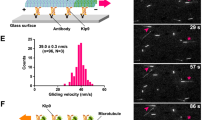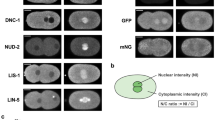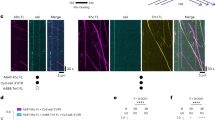Abstract
A PRODUCT encoded at the claret locus in Drosophila is needed for normal chromosome segregation in meiosis in females and in early mitotic divisions of the embryo1,2. The predicted amino-acid sequence of the segregation protein was shown recently to be strikingly similar to Drosophila kinesin heavy chain3. We have expressed the claret segregation protein in bacteria and have found that the bacterially expressed protein has motor activity in vitro with several novel features. The claret motor is slow (4 μm min−1), unlike either kinesin or dyneins. It has the directionality, the ability to generate torque and the sensitivity to inhibitors reported previously for dyneins. The finding of minus-end directed motor activity for a protein with sequence similarity to kinesin suggests that the dynein and kinesin motor domains are ancestrally related. The minus-end directed motor activity of the claret motor is consistent with a role for this protein in producing chromosome movement along spindle microtubules during prometaphase and/or anaphase.
This is a preview of subscription content, access via your institution
Access options
Subscribe to this journal
Receive 51 print issues and online access
$199.00 per year
only $3.90 per issue
Buy this article
- Purchase on Springer Link
- Instant access to full article PDF
Prices may be subject to local taxes which are calculated during checkout
Similar content being viewed by others
References
Sturtevant, A. H. Z. Wiss. Zool. 135, 323–356 (1929).
Lewis, E. B. & Gencarella, W. Genetics 37, 600–601 (1952).
Endow, S. A., Henikoff, S. & Niedziela, L. S. Nature 345, 81–83 (1990).
Yamamoto, A. H., Komma, D. J., Shaffer, C. D., Pirrotta, V. & Endow, S. A. EMBO J. 8, 3543–3552 (1989).
McDonald, H. B. & Goldstein, L. S. B. Cell 61, 991–1000 (1990).
Walker, R. A., Gliksman, N. R. & Salmon, E. D. in Optical Microscopy for Biology (eds Herman, B. & Jacobsen, K.) 395–407 (Wiley-Liss, New York, 1990).
Yang, J. T., Saxton, W. M., Stewart, R. J., Raff, E. G. & Goldstein, L. S. B. Science 249, 42–47 (1990).
Mcintosh, J. R. & Porter, M. E. J. biol. Chem. 284, 6001–6004 (1989).
Paschal, B. M. & Vallee, R. B. Nature 330, 181–183 (1987).
Cohn, S. A., Ingold, A. L. & Scholey, J. M. J. biol. Chem. 264, 4290–4297 (1989).
Vale, R. D., Schnapp, B. J., Reese, T. S. & Sheetz, M. P. Cell 40, 559–569 (1985).
Paschal, B. M., Shpetner, H. S. & Vallee, R. B. J. Cell Biol. 105, 1273–1282 (1987).
Paschal, B. M. et al. Nature 330, 672–674 (1987).
Vale, R. D. & Toyoshima, Y. Y. Cell 52, 459–469 (1988).
Belmont, L. D., Hyman, A. A., Sawin, K. E. & Mitchison, T. J. Cell 62, 579–589 (1990).
Hyman, A. A. et al. Meth. Enzym. (in the press).
Vale, R. D. et al. Cell 43, 623–632 (1985).
Vale, R. D. & Goldstein, L. S. B. Cell 60, 883–885 (1990).
Salmon, E. D. in Mitosis (eds Hyams, J. S. & Brinkley, B. R.) 119–181 (Academic, San Diego, 1989).
Studier, F. W., Rosenberg, A. H., Dunn, J. J. & Dubendorff, J. W. Meth. Enzym. 185, 60–89 (1990).
Walker, R. A. et al. J. Cell Biol. 107, 1437–1448 (1988).
Koshland, D. E., Mitchison, T. J. & Kirschner, M. W. Nature 331, 499–504 (1988).
Sale, W. S. & Fox, L. A. J. Cell Biol. 107, 1793–1797 (1988).
Kuznetsov, S. A. et al. EMBO J. 7, 353–358 (1988).
Author information
Authors and Affiliations
Rights and permissions
About this article
Cite this article
Walker, R., Salmon, E. & Endow, S. The Drosophila claret segregation protein is a minus-end directed motor molecule. Nature 347, 780–782 (1990). https://doi.org/10.1038/347780a0
Received:
Accepted:
Issue Date:
DOI: https://doi.org/10.1038/347780a0
This article is cited by
-
Anchoring geometry is a significant factor in determining the direction of kinesin-14 motility on microtubules
Scientific Reports (2022)
-
Motor generated torque drives coupled yawing and orbital rotations of kinesin coated gold nanorods
Communications Biology (2022)
-
Genome wide analysis of kinesin gene family in Citrullus lanatus reveals an essential role in early fruit development
BMC Plant Biology (2021)
-
CYK4 relaxes the bias in the off-axis motion by MKLP1 kinesin-6
Communications Biology (2021)
-
Kinesin-14 motors drive a right-handed helical motion of antiparallel microtubules around each other
Nature Communications (2020)
Comments
By submitting a comment you agree to abide by our Terms and Community Guidelines. If you find something abusive or that does not comply with our terms or guidelines please flag it as inappropriate.



